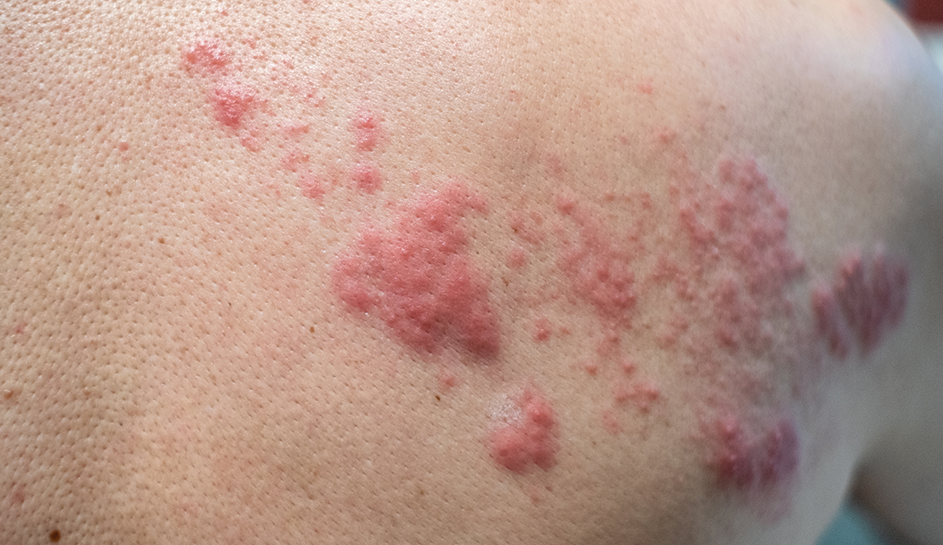
Herpes zoster (HZ) — more commonly known as shingles — is a vaccine-preventable disease that can result in long-term and serious complications. Patients suffering from HZ might seek advice from pharmacists on treatment and pain relief.
What is herpes zoster? Who is at risk?
Herpes zoster is a condition that causes painful rashes to appear on the skin. These rashes usually last between two to four weeks and may appear anywhere on the body. HZ is caused by the varicella-zoster virus (VZV) — the same pathogen responsible for chickenpox.
Shingles can only appear in people who have already been infected with VZV. At first contact with this virus, a person will develop chickenpox. After recovery, however, the virus will remain inactive in the body. Herpes zoster appears when it reactivates — yet, how this reactivation happens isn’t fully understood.
As such, the only people at risk of herpes zoster are those who have had chickenpox at some point. Persons with compromised immune systems (due to either drugs or medical conditions) are at an even greater risk of developing shingles. Similarly, older adults are also more prone to HZ due to lower resistance to the virus.
What is the prevalence and burden of herpes zoster?
Research shows that while chickenpox incidence has significantly decreased recently, herpes zoster has become more prevalent. It’s estimated that 7.2 out of 1000 persons will develop HZ at some point in their lives. This number increases with age: 8.45 for people between 50 and 59, and 10.46 for people older than 60.
Approximately 95 percent of the world population above 50 has been exposed to the varicella-zoster virus, meaning that most older people are at risk of developing HZ. This is even truer for people who haven’t been vaccinated for VZV — unvaccinated people over 85 have a 50 percent chance of developing shingles.
What are the potential long-term and severe complications of HZ?
Most people who get HZ won’t have any further complications — however, up to 18 percent of people will develop a long-term condition known as postherpetic neuralgia (PHN). PHN usually occurs where the HZ rash was, causing severe pain that may last for years, often requiring medication.
Less commonly, shingles may lead to other complications, including:
- Eye conditions, including blindness
- Hearing problems
- Pneumonia
- Infection of the lesions
- Hepatitis
- Encephalitis
Up to 4 percent of people with herpes zoster will require hospitalization due to these complications. In the most severe cases, HZ may even lead to death. It’s estimated that herpes zoster deaths have a prevalence of between 0.28 to 0.69 per 1 million people. Older people and those with compromised immune systems are more at risk of developing severe complications from shingles.
What are the available evidence and new indications for recombinant zoster vaccine?
A recent systematic review of the available evidence regarding herpes zoster vaccines found that vaccination can offer significant protection against this virus. Currently, there are two vaccines available for HZ: recombinant zoster vaccine (RZV) and zoster vaccine live (ZVL).
According to that same study, RZV is the better option for preventing HZ, offering a relative efficacy of 84 percent and a relative effectiveness of 49 percent. Relative efficacy refers to the protection this vaccine provides under ideal circumstances, while relative effectiveness indicates its superiority when compared to the existing medical treatments.
On the other hand, ZVL efficacy declines with age, making it less useful for older people who are arguably more at risk of developing severe HZ-related consequences. Furthermore, ZVL can slightly increase the incidence of adverse complications and may not be as effective when dealing with immunocompromised subjects.
As such, vaccination with RZV is the most promising prevention strategy for herpes zoster, showing very few safety concerns and high efficiency. However, more research may be required before establishing RZV as the standard strategy for HZ.
What are the NACI recommendations for HZ prevention?
The National Advisory Committee on Immunization (NACI) recommends administering vaccines to every person over 50 without contraindications. RZV is preferred over ZVL — however, ZVL may be considered whenever RZV is contraindicated or otherwise unavailable.
NACI also recommends paying attention to the duration of protection, as RZV starts being less efficient after four years and ZVL after three. Therefore, a second dose is recommended after a year has passed since the first immunization.
Learning more about HZ
Research regarding treatment options and prevention strategies for herpes zoster is still underway. You can learn more about HZ in our complimentary course for pharmacists.
Join the MDBriefCase community for free to stay current on clinical guidelines.
MDBriefCase and Pharmapod are members of the Think Research family of companies.
Share this Article
Recent Articles
Could Documentation Prevent the Next Medication Error?
Pharmacies today are busier than ever, and with time at a premium, it’s easy to overlook or downplay the importance of thorough medication error and
7 Guiding Principles to Cultivate a Just Culture in Your Pharmacy
Pharmacies, like all healthcare settings, have a responsibility to ensure patient safety. However, achieving a culture where safety is embedded in every action and decision
On-Demand Webinar: Safety Series Ep 3 – Just and Safety Culture in Healthcare: How Can it Improve Patient Safety
Discover how fostering a Just Culture can transform your pharmacy team’s approach to patient safety! While the importance of reporting medication errors and near misses



